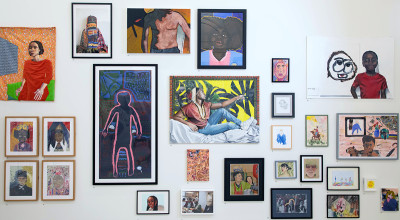Will there be fewer fine artists in the future?
By Jennifer Zielinska and Cornelia Parker
Published 3 March 2014
We put the question to Jennifer Zielinska, part of the RA’s attRAct programme, and Royal Academician and fine artist Cornelia Parker
-
From the Spring 2014 issue of RA Magazine, issued quarterly to Friends of the RA.
-
Yes...
The A-level students the RA works with are turning away from careers in fine art, says Jennifer Zielinska
During the past four years that I have been working with attRAct, the RA’s programme for A-level students, I have seen more and more students leaving school with a desire to study creative subjects. Yet very few of them see their future as fine artists.
The profile that art has held in secondary schools has been gradually weakening since 2006, when as an A-level student in a London grammar school, I participated in the attRAct programme. The English Baccalaureate, introduced in 2010 as a performance measure in secondary schools, does not include Art and Design as a core subject that contributes towards the measure. By omitting art subjects from this measure, artistically minded students are marginalised – discouraged from seeing art as a viable line of work – and schools are under less pressure to prioritise them.
According to UCAS statistics, between 2011 and 2012 there was a 16.3 per cent decline in students applying to creative arts and design courses; there was only a minor improvement of a 2.4 per cent increase between 2012 and 2013.
This shift away from art could also be blamed on a lack of information about the pathway to attend art college or the possibilities of studying art as a degree. Instead, the focus is on UCAS applications to more ‘academic’ subjects. Of course, there are still some teachers encouraging students to pursue art education, and popular art and design foundation courses are inundated with applications. However, among the attRAct students I work with, there are fewer budding Donald Judds or Gillian Wearings. Increasingly these artistic minds are seeking a way into graphics, animation, architecture, production design: creative subjects that are crucially seen as leading to creative careers in the way art is not.
-
Artistically minded students are marginalised – discouraged from seeing art as a viable line of work
Jennifer Zielinska
-
Are young people simply more savvy than they were in years gone by? The decisions students make these days are steered by the understanding that being a professional artist will not necessarily provide financial security or a stable career. Arts Council England’s budget has received a 33 per cent cut in real terms since 2010 and local authorities are cutting grants to cultural institutions; it is not surprising that a young person might be deterred from committing to such an uncertain career.
As well as this, high university fees mean there will be only a specific, affluent demographic who can afford to be students, let alone fine art students who have the added expense of studio rental and art materials. Consequently, an art student’s time is often depleted by casual work to pay for it all. This does not bode well for the sustainability of an eclectic assortment of artists that is the vital component of an evolving art scene.
-
Video
Learn more about the A-level programme attRAct
-
By no means am I underestimating that the skills developed through art education – independent thought, an understanding of critical context, an ability to provide both practical and beautiful solutions – are applicable to a variety of careers. But they are often deemed less valuable than perceived ‘academic’ credentials by prospective students keen to be seen as employable on graduation. I fear that because these abilities are not easily quantifiable, they are overlooked in favour of skills more in keeping with a traditional CV.
While we should count ourselves fortunate that the UK is a nation with many thriving creative industries, I think this means young people are deviating from fine art towards them – to the detriment of the vibrant tapestry of culture as we know it.
-
No...
There will always be people who want to be fine artists, provided the subject stays on the school curriculum, argues Cornelia Parker RA
Luckily, I went to art school in the 1970s and early ’80s, receiving six years of free education. Coming from a working-class background, having access to a full grant allowed me to fulfil my aspiration to become an artist.
My parents were hostile to the idea, but as they didn’t have to pay anything towards my education I didn’t need their approval. When they passed away five years ago they were still disappointed that I never got a proper job.
When I was at art school you didn’t expect to make a living out of your work like you might today. It seemed as if life as an artist was a philosophical quest – one where you expected to live in penury, but enlightened penury. It was worth the struggle because it was about freedom and rebellion, and a life worth living. Now art and the appreciation of art have become much more mainstream, no longer the rarified pursuits of the avant garde and consumed only by the upper classes. Through the Turner Prize giving everyman a chance to have an opinion, through museums being free, through media and social networks, there are now a lot more opportunities for artists, and an ever-expanding art world. Starting out now, one can possibly imagine approaching art as a financially viable career.
It seems that, increasingly, we will want art in our lives. More people are becoming collectors, whatever their class or income. The diversity of materials and means of expression available to artists today mean that works can be made for very little money. So many of my works over the years have been made from discarded objects at the end of the food chain. Lack of resources and space can certainly encourage you to be resourceful and think outside of the box.
There’s the cliche? of artists slaving away in their garrets, and it is true that with today’s rents, there are not many garrets to be had in London. When I first moved to the city in 1984, I squatted a house, and later I lived in a housing association property. There is now less and less cheap accommodation and studio space. There is no doubt that artists are getting squeezed.
-
Fine art is always going to be popular as a degree, but the average age of students will certainly increase
Cornelia Parker
-
But will artists need studios in the future? There is still a traditional romantic idea of what resources artists need to be artists. Working practices are fast evolving and, through the internet, new forums are being created. New strands of collaborative, socially orientated art are emerging that defy old notions of where the activity can take place. Artists such as Banksy or Jeremy Deller, who didn’t study fine art, have encouraged people to make work out on the street or in the community rather than in the studio.
I taught fine art at art schools until about 12 years ago, and even then there was a changing demographic because of the gradual introduction of tuition fees. In particular there was an increase in mature students. These included those who had made a lot of money, or empty-nesters who had always aspired to go to art school but only now had the time and could afford it. This trend will continue as fees rise. Fine art is always going to be popular as a degree, but the average age of students will certainly increase.
My main fear is about art education in schools. Education Minister Michael Gove’s promotion of the English Baccalaureate, with its emphasis on a narrow band of subjects, is sidelining art. The original thinking that develops when studying art, music and drama is a positive for every other single subject in the school curriculum. If this creativity gets squashed very early on, that’s a much bigger threat to the future of art than fewer applications to art schools. Since the creative industries are this country’s most lucrative export, our biggest manufacturing base, we should be very worried indeed when the genesis of such talent gets nipped in the bud.
attRAct offers London-based A-level Art students RA workshops, exhibition tours, studio visits, mentoring sessions in the RA Schools, gallery visits and careers and portfolio advice.
Find out how to enter A-Level Summer Exhibition Online



